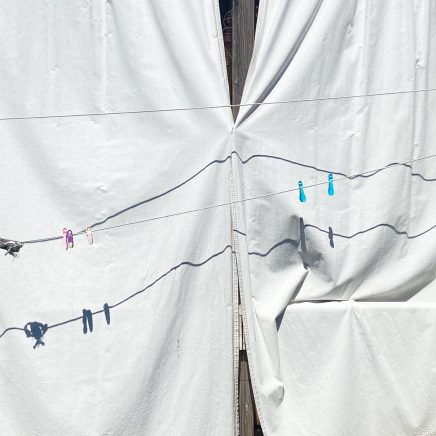
Nucleo: A Series of Photographs by Wouter Van de Voorde

**Nucleo: A Photographic Series by Wouter Van de Voorde**
The Australian-Belgian artist Wouter Van de Voorde is well-known for exploring the limits of landscape and portrait photography. With a sharp focus on texture, illumination, and geological epochs, Van de Voorde’s latest photographic series, *Nucleo*, serves as a contemplative journey into nature, recollection, and the transient nature of life.
### A Blend of Landscape and Sculpture
*Nucleo* represents a noteworthy advancement in Van de Voorde’s artistic journey, merging classic photographic methods with an increasing fascination for sculptural artistry. Central to the series are striking, hand-sculpted clay figures—primarily skulls and skeletal remnants—set against Australia’s rugged rural landscapes. These clay creations, adorned in earthy tones and resembling artifacts unearthed from ancient sites, are strategically positioned within nature, as though they are rising from or being enveloped by the land.
The outcome is an evocative and reflective collection of art. Each photograph encapsulates a moment where human existence aligns with geological history, alluding to the fleeting nature of life and the persistent strength of the earth.
### The Significance of “Nucleo”
The title *Nucleo* is derived from the Latin word for “core” or “nucleus,” hinting at the series’ conceptual foundation. Van de Voorde’s work probes into what constitutes the essence of existence—both physically and philosophically. The skeletal forms imply a removal of identity, reducing the human figure to its fundamental structural components. The surrounding landscapes—often sun-bleached, barren, and expansive—emphasize a sense of everlasting openness.
Van de Voorde seems to pose the question: What persists of us once everything else has vanished? The series refrains from providing straightforward answers, instead serving as a visual contemplation on decay, presence, and the flow of time.
### An Intimate Process Anchored in Place
The creation of *Nucleo* was as much a personal ritual as it was an artistic pursuit. Van de Voorde, residing near Canberra, shaped the skulls and bones by hand with clay gathered from his own garden. This choice infuses the work with profound personal significance and forges a tangible connection between the artifacts and the Australian earth upon which they are depicted.
The act of digging, crafting, and repositioning these figures adds an archaeological aspect to the work. Van de Voorde steps into the roles of both creator and excavator—a duality that highlights themes of memory and loss.
### Photography as Fossilization
In the *Nucleo* series, Van de Voorde’s employment of natural light, meticulous composition, and minimal editing crafts images that possess a timeless essence. The photographs seem ethereal yet anchored, as though the sculptural elements are fossils captured within their natural settings. Photography, in this context, acts as a preservative tool—a means to immortalize not only the object but the emotions they invoke.
This dynamic between endurance and fleetingness renders *Nucleo* particularly captivating. The clay may crack, the figures may wear away, but the photograph—a snapshot of existence etched into paper—remains.
### Reception and Legacy
Since its unveiling, *Nucleo* has attracted attention from critics and art lovers alike. The series has been showcased in galleries and publications throughout Australia and Europe, often lauded for its raw emotional resonance and conceptual intricacy. Spectators are moved not only by the haunting beauty of the figures but also by Van de Voorde’s seamless integration of these elements into their environments.
While grounded in the personal and local, *Nucleo* resonates with universal themes: the certainty of mortality, the tenacity of nature, and the human longing for remembrance.
### Conclusion
Wouter Van de Voorde’s *Nucleo* transcends a mere photographic collection—it represents a philosophical exploration manifested through clay and light. By contrasting ephemeral human forms with lasting landscapes, Van de Voorde encourages viewers to ponder their position within the larger continuum of life and time. Richly tactile, subtly haunting, and visually compelling, *Nucleo* stands as a testament to photography’s capacity to capture not simply images, but ideas that resonate like echoes beneath the earth’s surface.